The chromium zirconium copper rod market is forecast to expand from USD 398.8 million in 2025 to USD 755.7 million in 2035 at a CAGR of 6.6%. End-use industry dynamics demonstrate how construction, transportation, electrical systems, renewable energy, and healthcare influence adoption cycles. Consumption patterns show steady diversification as industries adopt high-strength, conductive alloys to replace conventional copper in demanding applications.
Construction growth is a primary demand driver. Large-scale infrastructure, smart city projects, and upgrades in commercial and residential networks are increasing demand for high-performance electrical conductors. Chromium zirconium copper rods offer superior strength and wear resistance while maintaining high conductivity, making them suitable for cabling, wiring, and structural reinforcement in modern building projects. Packaging regulations also shape consumption indirectly, as manufacturing and logistics rely on advanced welding and machinery that utilize these rods in their systems.
Automotive and electric vehicle production reinforces demand momentum. The transition toward lightweight, durable, and heat-resistant components creates applications in connectors, busbars, and electric drivetrains. High current-carrying capacity and superior fatigue resistance make chromium zirconium copper rods essential for long-term EV adoption. The same property advantages support aerospace and rail industries, where enhanced conductivity and strength balance performance with safety standards.
Adjacent industries expand the end-use base. Renewable energy deployment in wind turbines, solar farms, and energy storage facilities requires reliable high-performance conductors. Grid modernization and expansion of transmission infrastructure reinforce the role of these alloys in supporting efficiency and stability. Healthcare contributes incremental demand, as diagnostic and imaging devices, along with precision equipment, integrate high-conductivity materials to improve reliability and minimize downtime.
Structural demand drivers include rising investments in advanced electrical systems, preference for durable alloys with reduced maintenance costs, and ongoing industrial modernization across emerging economies. These long-term factors provide stability even when cyclical consumption in automotive or construction sectors shows temporary slowdowns. Cyclical consumption patterns, such as fluctuations in automotive sales or construction project delays, can create short-term volatility. Structural adoption in electrical grids and renewable projects balances these swings, providing a dependable base for growth.
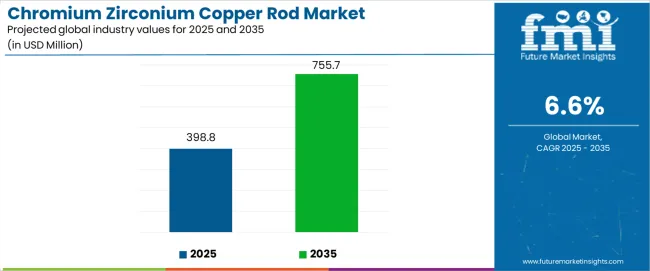
The chromium zirconium copper rod market demonstrates distinct growth phases with varying market characteristics and competitive dynamics. Between 2025 and 2030, the chromium zirconium copper rod market progresses through its advanced alloy adoption phase, expanding from USD 398.8 million to USD 514.9 million with steady annual increments averaging 5.2% growth. This period showcases the transition from basic copper alloys to advanced chromium zirconium systems with enhanced conductivity properties and integrated thermal management becoming mainstream features.
The 2025-2030 phase adds USD 116.1 million to market value, representing 43% of total decade expansion. Market maturation factors include standardization of diameter specifications, declining material costs for high-performance alloys, and increasing industrial awareness of premium rod benefits reaching 70-75% effectiveness in electrical and thermal applications. Competitive landscape evolution during this period features established manufacturers like Wieland Werke AG and KME AG expanding their product portfolios while new entrants focus on specialized diameter ranges and enhanced conductivity technology.
From 2030 to 2035, market dynamics shift toward advanced customization and multi-sector deployment, with growth accelerating from USD 514.9 million to USD 755.7 million, adding USD 240.8 million or 57% of total expansion. This phase transition logic centers on universal high-performance systems, integration with automated manufacturing equipment, and deployment across diverse application scenarios, becoming standard rather than specialized conductive formats. The competitive environment matures with focus shifting from basic diameter to comprehensive conductivity performance and compatibility with modern manufacturing operations.
At-a-Glance Metrics
| Metric | Value |
|---|---|
| Market Value (2025) | USD 398.8 million |
| Market Forecast (2035) | USD 755.7 million |
| Growth Rate | 6.60% CAGR |
| Leading Diameter Segment | Diameter 30-100mm |
| Primary Application | Electronics Industry |
The chromium zirconium copper rod market demonstrates strong fundamentals with Diameter 30-100mm systems capturing a dominant share through superior conductivity characteristics and cost-effective manufacturing capabilities. Electronics industry applications drive primary demand, supported by increasing semiconductor manufacturing requirements and enhanced thermal management solutions. Geographic expansion remains concentrated in developed markets with established manufacturing infrastructure, while emerging economies show accelerating adoption rates driven by industrialization projects and rising technology integration activity.
The chromium zirconium copper rod market represents a compelling intersection of advanced metallurgy innovation, electrical conductivity enhancement, and thermal management optimization. With robust growth projected from USD 398.8 million in 2025 to USD 755.7 million by 2035 at a 6.60% CAGR, this market is driven by increasing electronics miniaturization trends, aerospace component requirements, and automotive demand for reliable conductive formats.
The chromium zirconium copper rod market's expansion reflects a fundamental shift in how manufacturers and component producers approach electrical and thermal management infrastructure. Strong growth opportunities exist across diverse applications, from electronics operations requiring precision conductivity to aerospace facilities demanding high-strength solutions. Geographic expansion is particularly pronounced in Asia-Pacific markets, led by China (8.91% CAGR) and India (8.25% CAGR), while established markets in Europe and North America drive innovation and specialized segment development.
The dominance of Diameter 30-100mm systems and electronics applications underscores the importance of proven alloy technology and structural reliability in driving adoption. Material composition and manufacturing complexity remain key challenges, creating opportunities for companies that can deliver consistent performance while maintaining cost efficiency.
Market expansion rests on three fundamental shifts driving adoption across electronics and industrial sectors. Electronics miniaturization creates compelling advantages through chromium zirconium copper rod systems that provide comprehensive electrical conductivity with enhanced thermal management compatibility, enabling manufacturers to manage increasing power densities and maintain performance standards while ensuring efficient heat dissipation operations and justifying investment over basic copper methods. Industrial facility modernization accelerates as companies worldwide seek reliable conductive systems that deliver operational efficiency directly to manufacturing operations, enabling cost reduction that aligns with production expectations and maximizes electrical performance productivity. Technology advancement drives adoption from manufacturers requiring precision alloy solutions that maximize conductivity capacity while maintaining mechanical strength during processing and assembly operations.
The growth faces headwinds from raw material price variations that differ across chromium and zirconium suppliers regarding cost stability and supply chain reliability, potentially limiting margin consistency in price-sensitive industrial categories. Processing complexity also persists regarding heat treatment requirements and quality control standards that may increase manufacturing costs in markets with demanding performance protocols.
Primary Classification: The market segments by diameter into <30mm, 30-100mm, and >100mm categories, representing the evolution from precision small-diameter applications to large-scale industrial formats for comprehensive conductive operations.
Secondary Breakdown: Application segmentation divides the chromium zirconium copper rod market into electronics industry, aerospace, automobile manufacturing, industrial equipment, energy systems, and others sectors, reflecting distinct requirements for conductivity characteristics, mechanical specifications, and thermal performance.
Regional Classification: Geographic distribution covers Asia Pacific, Europe, North America, Latin America, and the Middle East & Africa, with developed markets leading innovation while emerging economies show accelerating growth patterns driven by industrialization programs.
The segmentation structure reveals technology progression from standard copper alloys toward integrated chromium zirconium platforms with enhanced conductivity and strength capabilities, while application diversity spans from electronics operations to industrial facilities requiring comprehensive electrical management and thermal dissipation solutions.
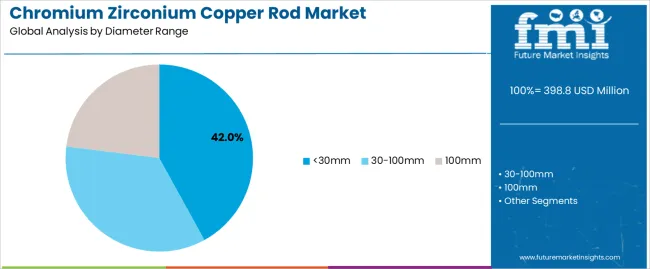
Diameter 30-100mm segment is estimated to account for 42% of the chromium zirconium copper rod market share in 2025. The segment's leading position stems from its fundamental role as a critical component in industrial applications and its extensive use across multiple electronics and manufacturing sectors. The 30-100mm diameter range's dominance is attributed to its optimal balance of conductivity capacity, mechanical strength, and processing versatility that make it indispensable for standard manufacturing operations.
Market Position: 30-100mm diameter systems command the leading position in the chromium zirconium copper rod market through advanced extrusion technologies, including comprehensive diameter control, uniform alloy distribution, and reliable manufacturing performance that enable producers to deploy conductive solutions across diverse application environments.
Value Drivers: The segment benefits from manufacturer preference for proven diameter profiles that provide exceptional electrical performance without requiring premium processing costs. Efficient production processes enable deployment in electronics components, automotive parts, and industrial applications where conductivity reliability and mechanical strength represent critical selection requirements.
Competitive Advantages: 30-100mm diameter systems differentiate through excellent current-carrying capacity, proven thermal management, and compatibility with standard processing equipment that enhance conductive capabilities while maintaining economical material profiles suitable for diverse manufacturing applications.
Key market characteristics:
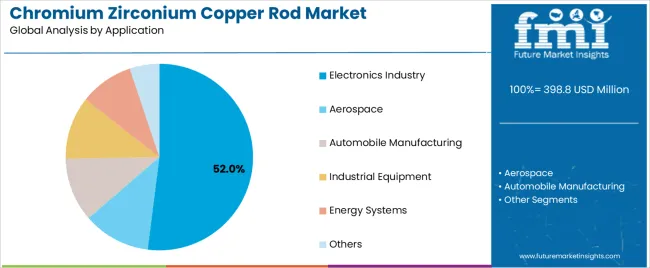
Electronics Industry segment is projected to hold 52% of the chromium zirconium copper rod market share in 2025. The segment's market leadership is driven by the extensive use of chromium zirconium copper rods in semiconductor manufacturing, electronic components, circuit boards, and electrical contacts, where conductive alloys serve as both an electrical pathway and thermal management solution. The electronics sector's consistent demand for reliable conductive materials supports the segment's dominant position.
Market Context: Electronics applications dominate the chromium zirconium copper rod market due to widespread adoption of miniaturization technologies and increasing focus on thermal management, current density optimization, and signal integrity that enhance device performance while maintaining reliability standards.
Appeal Factors: Electronics manufacturers prioritize electrical conductivity, thermal dissipation, and integration with automated assembly systems that enable coordinated deployment across multiple component needs. The segment benefits from substantial semiconductor growth and technology advancement that emphasize reliable conductive systems for electronic applications.
Growth Drivers: Semiconductor fabrication facilities incorporate chromium zirconium copper rods as standard components for electrical contacts and thermal management systems. At the same time, consumer electronics initiatives are increasing demand for premium performance features that comply with industry standards and enhance device functionality.
Market Challenges: Raw material cost fluctuations and diameter precision requirements may limit deployment flexibility in ultra-price-sensitive markets or regions with varying manufacturing standards.
Application dynamics include:
Growth Accelerators: Electronics miniaturization drives primary adoption as chromium zirconium copper rod systems provide exceptional conductivity capabilities that enable electrical management without signal degradation, supporting performance improvement and manufacturing efficiency that require reliable alloy formats. Industrial modernization accelerates market expansion as facilities seek precision conductive solutions that maintain electrical integrity during operation while enhancing thermal management through optimized diameter sizing and material compatibility. Technology advancement increases worldwide, creating sustained demand for high-performance conductive systems that complement manufacturing routines and provide operational advantages in electrical efficiency.
Growth Inhibitors: Raw material volatility challenges differ across chromium and zirconium markets regarding price stability and supply chain consistency, which may limit margin predictability and cost planning in price-sensitive industrial categories with demanding affordability requirements. Processing complexity persists regarding heat treatment standards and quality control requirements that may increase manufacturing costs in jurisdictions with strict performance protocols. Market fragmentation across multiple diameter specifications and alloy compositions creates compatibility concerns between different manufacturing systems and existing processing infrastructure.
Market Evolution Patterns: Adoption accelerates in electronics and industrial sectors where performance benefits justify material investments, with geographic concentration in developed markets transitioning toward mainstream adoption in emerging economies driven by industrialization and manufacturing development. Technology advancement focuses on enhanced alloy properties, improved processing efficiency, and integration with automated manufacturing systems that optimize conductivity performance and production consistency. The chromium zirconium copper rod market could face disruption if alternative conductive materials or processing technologies significantly challenge traditional chromium zirconium copper advantages in electrical applications.
The chromium zirconium copper rod market demonstrates varied regional dynamics with growth leaders including China (8.91% CAGR) and India (8.25% CAGR) driving expansion through industrialization growth and manufacturing modernization. Steady Performers encompass Germany (7.59% CAGR), Brazil (6.93% CAGR), and the U.S. (6.27% CAGR), benefiting from established manufacturing systems and premium product adoption.
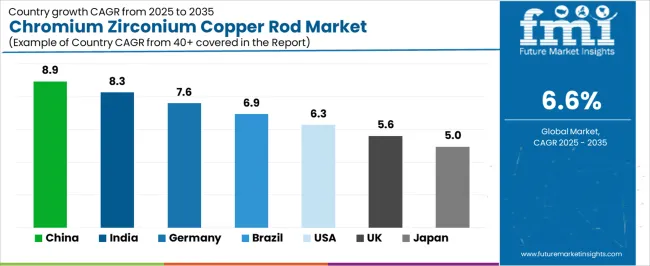
| Country | CAGR (2025-2035) |
|---|---|
| China | 8.91 |
| India | 8.25 |
| Germany | 7.59 |
| Brazil | 6.93 |
| U.S. | 6.27 |
| U.K. | 5.61 |
| Japan | 4.95 |
Regional synthesis reveals Asia-Pacific markets leading growth through industrial expansion and manufacturing development, while European countries maintain steady expansion supported by specialized applications and quality requirements. North American markets show strong growth driven by electronics demand and automotive industry upgrades.
China establishes regional leadership through rapid industrial development and comprehensive manufacturing modernization, integrating advanced chromium zirconium copper rod systems as standard components in electronics production and automotive manufacturing operations. The country's 8.91% CAGR through 2035 reflects industrial growth promoting manufacturing density and infrastructure development that mandate the use of reliable conductive systems in electrical applications. Growth concentrates in major industrial centers, including Shenzhen, Shanghai, and Guangzhou, where manufacturing networks showcase integrated chromium zirconium copper systems that appeal to component manufacturers seeking enhanced conductivity efficiency and international quality standards.
Chinese manufacturers are developing innovative chromium zirconium copper rod solutions that combine local production advantages with international performance specifications, including precision diameter control and advanced alloy composition capabilities.
Strategic Market Indicators:
The Indian market emphasizes manufacturing applications, including rapid industrial development and comprehensive electronics expansion that increasingly incorporates chromium zirconium copper rods for component production and automotive applications. The country is projected to show an 8.25% CAGR through 2035, driven by massive industrialization activity under manufacturing initiatives and component demand for standardized, high-quality conductive systems. Indian manufacturing facilities prioritize cost-effectiveness with chromium zirconium copper rods delivering operational efficiency through economical material usage and reliable performance capabilities.
Technology deployment channels include major electronics manufacturers, automotive companies, and industrial facilities that support high-volume usage for domestic and export applications.
Performance Metrics:
The German market emphasizes advanced chromium zirconium copper rod features, including innovative alloy technologies and integration with comprehensive manufacturing platforms that manage automotive production, electronics operations, and industrial applications through unified conductive systems. The country is projected to show a 7.59% CAGR through 2035, driven by industrial expansion under automotive development trends and manufacturing demand for premium, reliable conductive systems. German manufacturers prioritize precision with chromium zirconium copper rods delivering comprehensive electrical management through enhanced conductivity protection and operational innovation.
Technology deployment channels include major automotive manufacturers, electronics companies, and industrial facilities that support custom development for premium operations.
Performance Metrics:
In São Paulo, Rio de Janeiro, and Minas Gerais, Brazilian manufacturing facilities and industrial operators are implementing advanced chromium zirconium copper rod systems to enhance production capabilities and support operational efficiency that aligns with industrial protocols and manufacturing standards. The Brazilian market demonstrates sustained growth with a 6.93% CAGR through 2035, driven by industrial development programs and manufacturing investments that emphasize reliable conductive systems for automotive and electronics applications. Brazilian industrial facilities are prioritizing chromium zirconium copper rod systems that provide exceptional electrical properties while maintaining compliance with manufacturing standards and minimizing processing complexity, particularly important in automotive manufacturing and electronics production operations.
Market expansion benefits from industrial programs that mandate enhanced conductivity in manufacturing specifications, creating sustained demand across Brazil's automotive and electronics sectors, where electrical performance and material consistency represent critical requirements.
Strategic Market Indicators:
The U.S. market emphasizes advanced chromium zirconium copper rod features, including innovative manufacturing technologies and integration with comprehensive production platforms that manage electronics manufacturing, aerospace operations, and automotive applications through unified conductive systems. The country is projected to show a 6.27% CAGR through 2035, driven by technology expansion under manufacturing development trends and industrial demand for premium, reliable conductive systems. American manufacturers prioritize innovation with chromium zirconium copper rods delivering comprehensive electrical management through enhanced conductivity protection and operational excellence.
Technology deployment channels include major electronics manufacturers, aerospace companies, and automotive facilities that support advanced development for high-performance operations.
Performance Metrics:
The U.K. market demonstrates meticulous chromium zirconium copper rod deployment, growing at 5.61% CAGR, with documented operational excellence in electronics manufacturing and aerospace applications through integration with existing production systems and quality assurance infrastructure. The country leverages engineering expertise in metallurgy and precision manufacturing to maintain market leadership. Industrial centers, including London, Birmingham, and Manchester, showcase advanced installations where chromium zirconium copper rod systems integrate with comprehensive manufacturing platforms and quality systems to optimize production and operational efficiency.
British manufacturing facilities prioritize conductivity precision and material consistency in product selection, creating demand for premium chromium zirconium copper rod systems with advanced features, including precision diameter control and integration with automated manufacturing protocols. The chromium zirconium copper rod market benefits from established industrial infrastructure and willingness to invest in specialized alloy technologies that provide superior electrical properties and regulatory compliance.
Market Intelligence Brief:
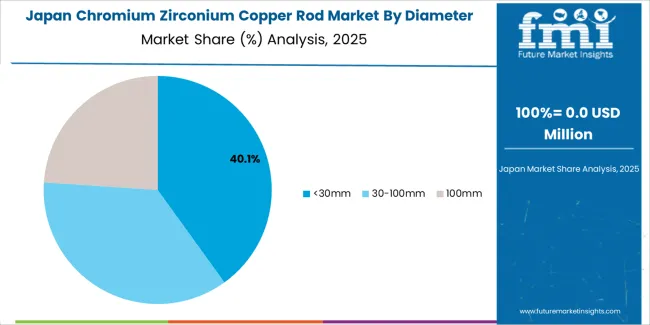
Japan's sophisticated manufacturing market demonstrates meticulous chromium zirconium copper rod deployment, growing at 4.95% CAGR, with documented operational excellence in electronics production and automotive applications through integration with existing manufacturing systems and precision control infrastructure. The country leverages engineering expertise in metallurgy and precision manufacturing to maintain market leadership. Manufacturing centers, including Tokyo, Osaka, and Nagoya, showcase advanced installations where chromium zirconium copper rod systems integrate with comprehensive production platforms and automation systems to optimize manufacturing and operational efficiency.
Japanese manufacturing facilities prioritize conductivity precision and alloy consistency in product selection, creating demand for premium chromium zirconium copper rod systems with advanced features, including ultra-precise diameter control and integration with automated production protocols. The chromium zirconium copper rod market benefits from established manufacturing infrastructure and a willingness to invest in specialized alloy technologies that provide superior electrical properties and quality compliance.
Market Intelligence Brief:
The chromium zirconium copper rod market in Europe is projected to grow from USD 142.3 million in 2025 to USD 267.8 million by 2035, registering a CAGR of 6.5% over the forecast period. Germany is expected to maintain its leadership position with a 38.4% market share in 2025, declining slightly to 37.9% by 2035, supported by its automotive manufacturing excellence and major industrial centers, including Bavaria and Baden-Württemberg.
France follows with a 22.7% share in 2025, projected to reach 23.1% by 2035, driven by comprehensive aerospace programs and electronics facility initiatives. The United Kingdom holds a 16.8% share in 2025, expected to maintain 17.2% by 2035 through established manufacturing sectors and industrial adoption. Italy commands a 13.5% share, while Spain accounts for 6.9% in 2025. The Rest of Europe region is anticipated to gain momentum, expanding its collective share from 1.7% to 2.4% by 2035, attributed to increasing industrial development in Eastern European countries and emerging manufacturing programs implementing advanced conductive systems.
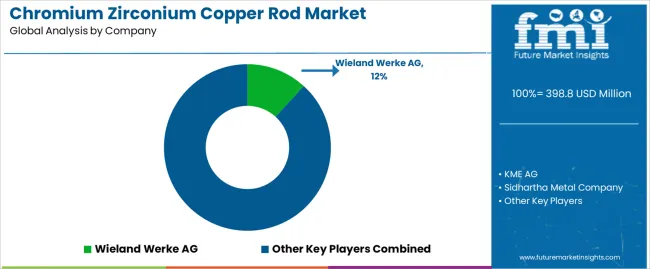
The chromium zirconium copper rod market operates with moderate concentration, featuring approximately 15-22 participants, where leading companies control roughly 45-52% of the global market share through established distribution networks and comprehensive manufacturing capabilities. Competition emphasizes alloy performance, processing consistency, and technical support rather than premium feature rivalry.
Market leaders encompass Wieland Werke AG, KME AG, and sidhartha Metal Company, which maintain competitive advantages through extensive metallurgy expertise, global distribution networks, and comprehensive technical support capabilities that create manufacturer loyalty and support industrial requirements. These companies leverage decades of alloy production experience and ongoing processing technology investments to develop advanced chromium zirconium copper rod systems with exceptional conductivity and mechanical features.
Specialty challengers include Metelec, Texton, and Ningbo Boway Alloy, which compete through specialized application innovation focus and efficient manufacturing solutions that appeal to industrial buyers seeking reliable performance formats and custom diameter flexibility. These companies differentiate through operational efficiency emphasis and specialized market focus.
Market dynamics favor participants that combine consistent electrical performance with advanced manufacturing support, including automated processing and distribution capabilities. Competitive pressure intensifies as traditional copper manufacturers expand into chromium zirconium systems. At the same time, specialized alloy producers challenge established players through innovative composition formulations and cost-effective production targeting emerging electronics segments.
| Item | Value |
|---|---|
| Quantitative Units | USD 398.8 million |
| Diameter Range | <30mm, 30-100mm, >100mm |
| Application | Electronics Industry, Aerospace, Automobile Manufacturing, Industrial Equipment, Energy Systems, Others |
| Regions Covered | Asia Pacific, Europe, North America, Latin America, Middle East & Africa |
| Countries Covered | China, India, Germany, Brazil, U.S., U.K., Japan, and 25+ additional countries |
| Key Companies Profiled | Wieland Werke AG, KME AG, sidhartha Metal Company, Metelec, Texton, Ningbo Boway Alloy |
| Additional Attributes | Dollar sales by diameter and application categories, regional adoption trends across Asia Pacific, Europe, and North America, competitive landscape with metallurgy manufacturers and specialty alloy producers, industrial preferences for conductivity characteristics and mechanical performance, integration with manufacturing equipment and processing systems, innovations in alloy composition technology and heat treatment systems, and development of specialized conductive solutions with enhanced electrical properties and corrosion resistance features |
The global chromium zirconium copper rod market is estimated to be valued at USD 398.8 million in 2025.
The market size for the chromium zirconium copper rod market is projected to reach USD 755.7 million by 2035.
The chromium zirconium copper rod market is expected to grow at a 6.6% CAGR between 2025 and 2035.
The key product types in chromium zirconium copper rod market are <30mm, 30-100mm and 100mm.
In terms of application, electronics industry segment to command 52.0% share in the chromium zirconium copper rod market in 2025.






Full Research Suite comprises of:
Market outlook & trends analysis
Interviews & case studies
Strategic recommendations
Vendor profiles & capabilities analysis
5-year forecasts
8 regions and 60+ country-level data splits
Market segment data splits
12 months of continuous data updates
DELIVERED AS:
PDF EXCEL ONLINE
Chromium Polynicotinate Market Size and Share Forecast Outlook 2025 to 2035
Chromium Trioxide Market Size and Share Forecast Outlook 2025 to 2035
Chromium Picolinate Market Size and Share Forecast Outlook 2025 to 2035
Chromium Salts Market Trends - Growth, Demand & Forecast 2025 to 2035
Zirconium Dioxide Market
Potassium Zirconium Fluoride Market
Rodent Control Pesticides Market Size and Share Forecast Outlook 2025 to 2035
Produced Water Treatment System Market Size and Share Forecast Outlook 2025 to 2035
Product Life-Cycle Management (PLM) IT Market Size and Share Forecast Outlook 2025 to 2035
Product Analytics Software Market Size and Share Forecast Outlook 2025 to 2035
Produce Packaging Market Size and Share Forecast Outlook 2025 to 2035
Products from Food Waste Industry Analysis in Korea Size, Share and Forecast Outlook 2025 to 2035
Products from Food Waste in Japan - Size, Share, and Forecast Outlook 2025 to 2035
Production Logistics Market Size and Share Forecast Outlook 2025 to 2035
Products from Food Waste Market Analysis - Size, Growth, and Forecast 2025 to 2035
Product Design Verification And Validation Solution Market Size and Share Forecast Outlook 2025 to 2035
Production Printer Market - Growth, Demand & Forecast 2025 to 2035
Produce Bag Market Trends & Industry Growth Forecast 2024-2034
Product Information Management Market Growth – Trends & Forecast 2024-2034
Product Dispensing Machinery Market

Thank you!
You will receive an email from our Business Development Manager. Please be sure to check your SPAM/JUNK folder too.
Chat With
MaRIA